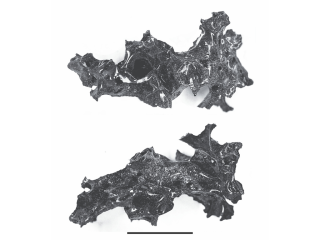
Fragment of glassy black material extracted from the cranial cavity of a victim of the volcanic eruption at Herculaneum in the year 79.
When Mount Vesuvius erupted in the year 79, the volcano unleashed an avalanche of gas and rock hot enough to boil blood, vaporize flesh and even transform bits of brain tissue into glass, according to a new study.
Archaeologists rarely uncover human brains during their digs, and if they do, the organs feel soap-like and smooth. During a process called saponification, triglycerides in the fatty brain tissue react with charged particles in the surrounding environment, transforming into soap over time. Scientists found something very different, however, when they examined the remains of a man who perished in Herculaneum during the Vesuvius eruption.
Enveloped in a surge of hot ash, the victim’s brain had been burned to twisted black bits through a process called vitrification. The glassy material “encrusted” the surface of the man’s skull, according to a report published Jan. 22 in the The New England Journal of Medicine.
The unusual discovery was made by Dr. Pier Paolo Petrone, a professor of human osteobiology and forensic anthropology at the Federico II University Hospital in Naples, Italy. In previous work, Petrone and his colleagues examined the skeletal remains of more than 300 people in Herculaneum who had fled to boathouses during the Vesuvius eruption, only to die from the extreme heat of the volcanic blast.
Herculaneum lies about 11 miles (20 kilometers) from Pompeii, also famously buried by the eruption, and sits closer to the base of Vesuvius. This proximity to the volcano ensured that people in Herculaneum met a particularly gruesome fate: Steam let off by their boiling blood generated intense pressure in their skulls, causing their heads to explode.
In their new study, Petrone and his co-authors examined a Vesuvius victim who had died not on the waterfront, but on a wooden bed in a building known as the Collegium Augustalium. The corpse was found in the 1960s, buried within a mound of volcanic ash. Like the boathouse victims, the charred skeleton bears the sparse remnants of a skull that burst during the eruption.
The team spotted shards of glassy black material lodged within remnants of the exploded skull and scattered among the remains of the cranial cavity. Co-author Piero Pucci of the Centro di Ingegneria Genetica-Biotecnologie Avanzate in Naples took the shards of brain tissue and analyzed the proteins found within.
The analysis revealed proteins known to be found in different areas of the human brain, including the wrinkled cerebral cortex, responsible for higher brain functions like decision-making; the amygdala, important to emotional processing; and the substantia nigra, which helps control movement and our response to rewards. Pucci also spotted fatty acids typically found in human hair grease, along with triglycerides commonly found in brain tissue samples.
Based on analysis of the charred wood found near the corpse, the team determined that the room likely reached a maximum temperature of 968 degrees Fahrenheit (520 degrees Celsius). The extreme temperature would have been hot enough to “vaporize soft tissues” in the victim’s body and burn every last trace of fat. Following the brief blast of heat, the body would have rapidly cooled, leaving behind the grisly remains of an exploded skull coated in vitrified brain bits, the authors noted.
Sourse: www.livescience.com





